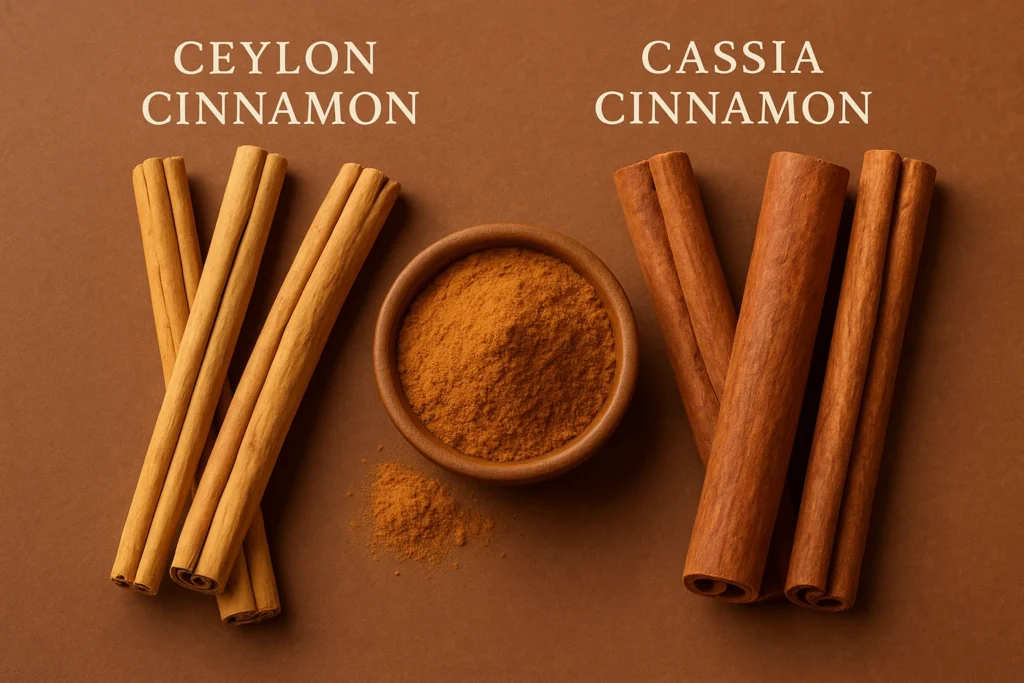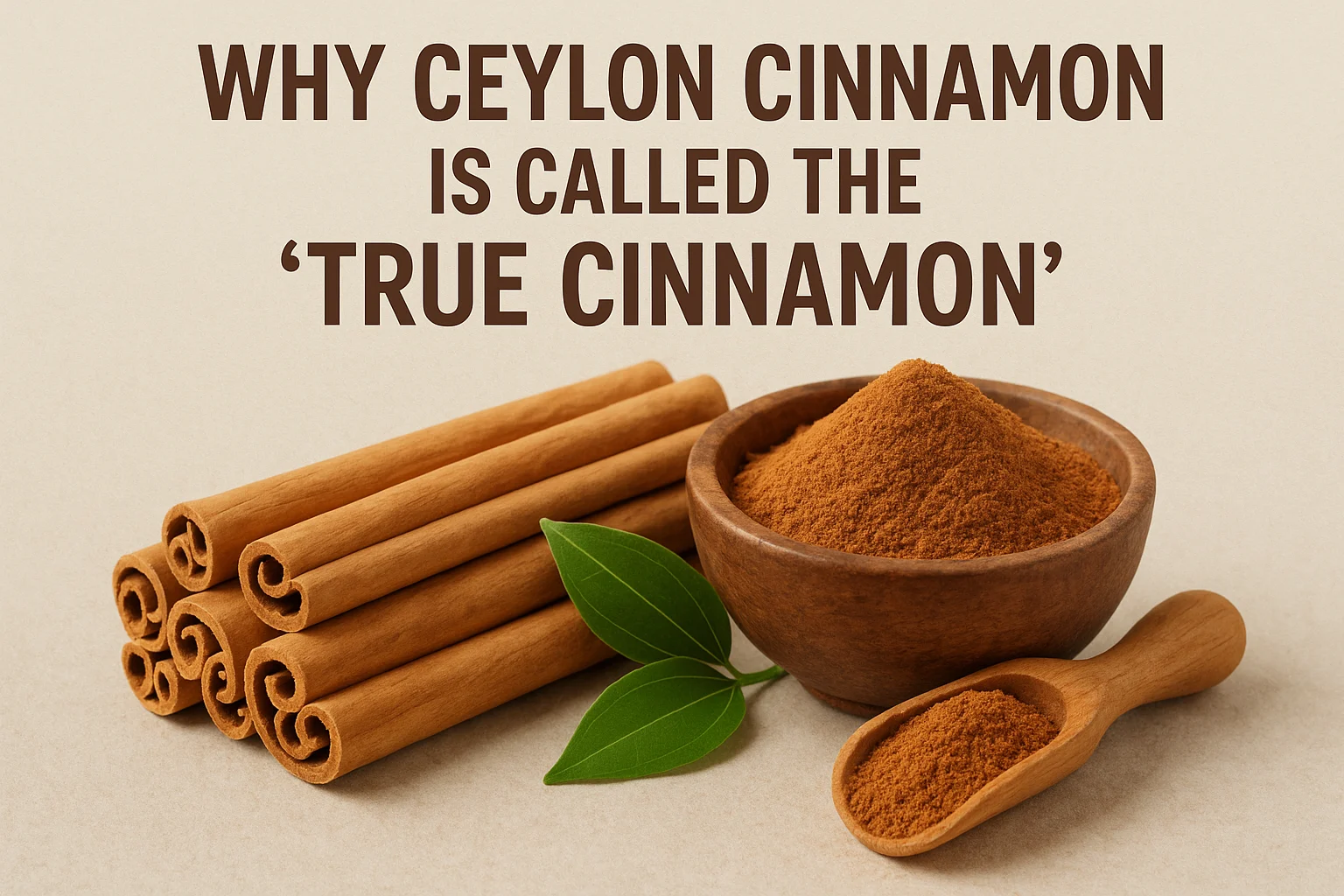Cinnamon is one of the most beloved spices, gracing everything from morning coffee to gourmet desserts. Its aromatic presence made it a golden treasure from the kitchen to the continents. However, most people don’t realize that the cinnamon they are using daily might not be what they think it is. There are two main types of cinnamon: Ceylon cinnamon or true cinnamon and Cinnamon cassia. Ceylon is the authentic spice and another one is a common substitute with hidden toxins that can be harmful when consumed regularly. Let’s explore why these spice differences matter and how you can ensure you are choosing the healthy spice for daily use.
Different Types of Cinnamon

Cinnamon is a different type of spice derived from the inner bark of Cinnamomum trees belonging to the Cinnamomum genus. After harvest, the fragrant bark is dried and turned into quills or cinnamon sticks. Compounds like cinnamaldehyde and other essential oils give the spice its unique qualities.
The cinnamon family has two main categories:
Ceylon Cinnamon (Cinnamomum verum) is the original cinnamon native to Sri Lanka. “Verum” means “true” in Latin, this is the authentic spice that ancient traders prized and that shaped history.
Cassia Cinnamon (Cinnamomum cassia), also known as Chinese cinnamon, represents several subspecies commonly sold in stores. It has become the default option due to its abundance and lower cost. The distinction between the types of cinnamon fundamentally affects what you are putting in your body every time you use this spice.
Table of Comparison
| Attribute | Ceylon cinnamon | Cassia cinnamon |
| Botanical name | Cinnamomum verum | Cinnamomum cassia / C. aromaticum |
| Origin | Sri Lanka, Southern India | China, Indonesia, Vietnam |
| Colour | Light tan-brown | Dark reddish-brown |
| Texture & Stick Shape | Thin, soft, multi-layered quills resembling a cigar | Hard, thick sticks with solid core or single fold |
| Flavor Profile | Sweet, delicate, subtle, refined | Strong, pungent, spicy, sometimes bitter |
| Aroma | Light, fragrant, complex | Intense, sharp, one-dimensional |
| Coumarin Content | Ultra-low (0.004%) | High (1–5%, up to 250x more) |
| Safety for Regular Use | Safe for daily consumption | Risk of liver/kidney damage with regular use |
| Texture When Broken | Fragile, easily crumbles | Very hard, difficult to break |
| Price & Quality | Expensive, premium, highly prized | Cheaper, widely available, lower quality |
| Primary Compound | Balanced cinnamaldehyde Balanced cinnamaldehyde with complex oils | ~95% cinnamaldehyde, more aggressive |
This comparison chart between Ceylon vs Cassia reveals why experts consistently recommend Ceylon for anyone using cinnamon regularly, whether for culinary purposes or health benefits.
Why Ceylon Cinnamon Is Known as True Cinnamon or Real Cinnamon
The origin, quality and safety of Ceylon cinnamon make it the “true cinnamon.” Native to regions of Southern India and Sri Lanka (formerly Ceylon), it is valued for its mild flavour and low coumarin content, which is around 250 times lower than that of Cassia and suitable for everyday usage. As a safer cinnamon choice, Ceylon sticks are tan-brown in appearance, with thin, soft layers in a rolled form. This premium spice has a pleasantly sweet flavour that works well in a variety of recipes and sweets. Its high cost is a result of the labour-intensive harvesting process and the precise rolling of hand-peeled bark.
What is False Cinnamon
The false cinnamon definition refers to Cassia (Cinnamon cassia or Cinnamon aromaticum) that are a cheap and widely sold supermarket variety.
- Appearance: Dark, thick, hard sticks.
- Flavor: Strong, spicy, pungent due to high cinnamaldehyde.
- Coumarin Content: 1–5% if consumed in excess, Cassia toxicity can be high.
Regular intake of 1–2 teaspoons may exceed the daily recommended limit, potentially affecting the liver and kidneys due to high coumarin risk.
How to Identify True Cinnamon
Identifying true cinnamon from Cassia doesn’t require laboratory testing, you can identify true cinnamon through simple observation and texture tests.
Colour
Ceylon: Light tan-brown, almost sandy.
Cassia: Dark reddish-brown to rust colour.
Stick Structure
Ceylon: Multiple thin, soft layers rolled like a cigar. You will see many delicate layers when looking at the end.
Cassia: Thick, hard stick with a single fold or solid core. Only one thick layer is visible.
Texture
Ceylon: Fragile and easily breaks or crumbles into flakes.
Cassia: Very hard and woody, requires force to break.
Aroma
Ceylon: Light, sweet and fragrant with warm complexity.
Cassia: Strong, sharp and intensely spicy.
Taste
Ceylon: Delicate sweetness with subtle warmth.
Cassia: Powerful, pungent spiciness with a slightly bitter aftertaste.
Explore Ceylon’s True Cinnamon with Kerala Spices Online
Ceylon cinnamon offers not just premium flavor but also health benefits. It is rich in antioxidants, supports anti-inflammatory processes and Ceylon cinnamon health benefits may help to regulate blood sugar. Kerala Spices Online sources authentic, organic Ceylon cinnamon, ensuring quality and safety. Discover more about Ceylon’s true cinnamon and Buy true cinnamon for your daily use.
Conclusion
Choosing the best cinnamon in between Ceylon and Cassia has its uses, but Ceylon cinnamon stands out for its superior taste, safety and overall quality. For regular use and safe cinnamon consumption, particularly in cooking and daily health routines, choosing true cinnamon ensures a safer, more flavorful experience. Make the switch to real cinnamon and enhance your culinary quality and your wellbeing. If you are looking for premium quality ceylon cinnamon choose kerala spices online. Buy ceylon cinnamon today.

